Soils and wildlife gardens
Soils are amongst the most extensive and important ecosystems on earth. The total area of gardens in the UK is estimated at about 433,000 hectares, a fifth the size of Wales. Allotments cover a further 11,300 hectares. By caring for the health of those soils we can do much to protect biodiversity as well as grow healthy flowers and vegetables.
Soils are the product of thousands of years of co-creation by physical erosion processes and the plants and animals that depend on them. A healthy soil supports a full diversity of life above and below ground and is integral to its major processes and cycles such as carbon storage and water cycling.
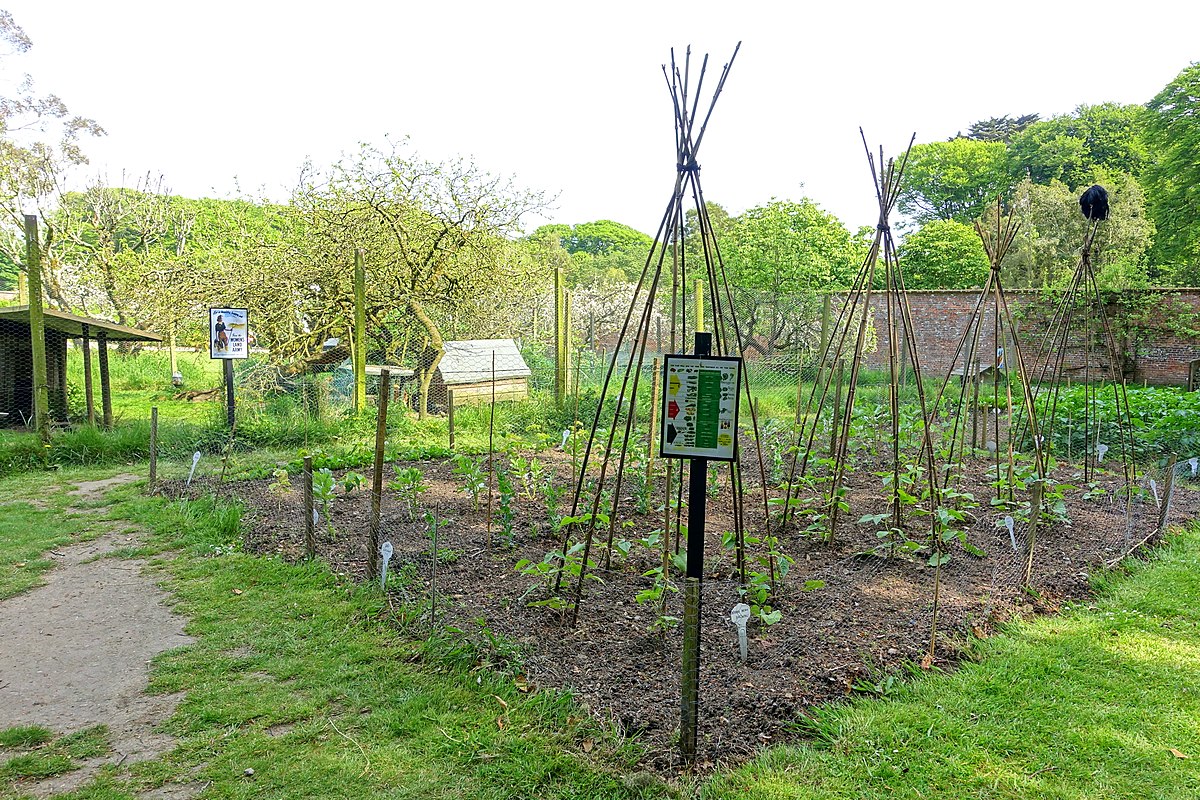
Trengwainton kitchen garden in Cornwall. It's obvious that successful vegetable and fruit gardening depends on the state of your soil - but in fact everything in your garden requires healthy soil.
Components of soil
Soils are an intimate blend of mineral particles of a range of sizes, organic matter in varying stages of decay, water, air, plant nutrients and an amazing diversity of fungi, microbes and tiny animals. To be healthy, soils must contain all these components.
Minerals
Soil minerals arise from aeons of erosion of bedrock by frost, rain, roots and organic acids. They occur in particles ranging from extremely tiny to big stones.
|
Particle type
|
Particle diameter
|
|
Clay
|
less than 0.002mm
|
|
Silt
|
0.002mm to 0.063mm
|
|
Sand
|
0.063mm to 2mm
|
|
Gravel
|
2mm to 64mm
|
|
Cobbles
|
64mm to 25cm
|
Gravel and sand make up the greatest part of soils by bulk. They are mostly chemically inert, often made up of flint and other forms of silica. They add little beyond structure, but that does not make them unimportant. The three-dimensional matrix they settle into creates many of the pores and channels by which roots grow into the depths and water and air can enter the soil.
The very smallest mineral particles, clays and silts, are very different. They have complex microstructures that create an enormous surface area for their mass. This and their ionic charges makes them chemically active; they bind to each other and help to form the larger clods that also benefit soil structure. They hold water and plant nutrients that would otherwise drain away; they help to resist erosion, they also shelter the very tiniest bacteria, fine root hairs and fungal hyphae. Together with organic matter, clay particles are where most important soil processes take place.
Dead organic matter
Fully decayed organic matter, known as humus, is like clays in its properties, micro-porous and ionically charged, it too holds water and nutrients and provides shelter for microorganisms. Organic matter eventually oxidises and disappears, leaving soils dry and infertile, so a constant resupply is important to maintain levels of humus. In natural habitats this happens through the in-situ accumulation of dead leaves and twigs. Gardeners who remove “unsightly” dead plant material will have to replace it with mulches of compost.

Handful of rich brown humus
Plant nutrients
To grow well, plants need a wide range of nutrients in various amounts, depending on the individual plant and its stage of growth. The three key plant nutrients plant roots pick up (alongside water) from soil are nitrogen, phosphorus and potassium, while carbon dioxide is absorbed from the air. Other vital soil nutrients include magnesium, calcium and sulphur. Gardeners can add nutrients by applying fertilisers (either artificial or naturally derived) to boost plant growth and improve flowering and fruiting.
Air and water
Healthy soils contain air and water between the mineral grains. Water is essential for plant growth, while oxygen is needed for roots, and for the tiny animals in the soil. Both are usually available, but when soils are saturated with water, oxygen is excluded and toxic chemicals like hydrogen sulphide can build up. By contrast, very coarse sandy soils will have lots of air spaces but lose water quickly. Even the best soils can be easily damaged by compaction where machinery or people repeatedly walking on them compress the soil and destroy the network of spaces between grains. Raised beds are one way that gardeners can manage their plants without treading on the soil, and digging is then unnecessary.
Living creatures
Soils have a vital role in recycling dead plant and animal material, releasing their tissues back into soil as nutrients for plants. There are many types of animals which physically break up the dead matter, including woodlice, insects, mites and worms, plus a myriad of microscopic animals that carry on the process at a smaller scale. The most vital living soil creatures are the fungi, single-celled animals and bacteria that can break down material chemically to release nutrients. Indeed some bacteria also have a role in converting inert atmospheric nitrogen into chemically fixed nitrogen that plants can use. Some fungi have an equally vital role in forming symbiotic mycorrhizal associations with plant roots helping them take up water and nutrients.
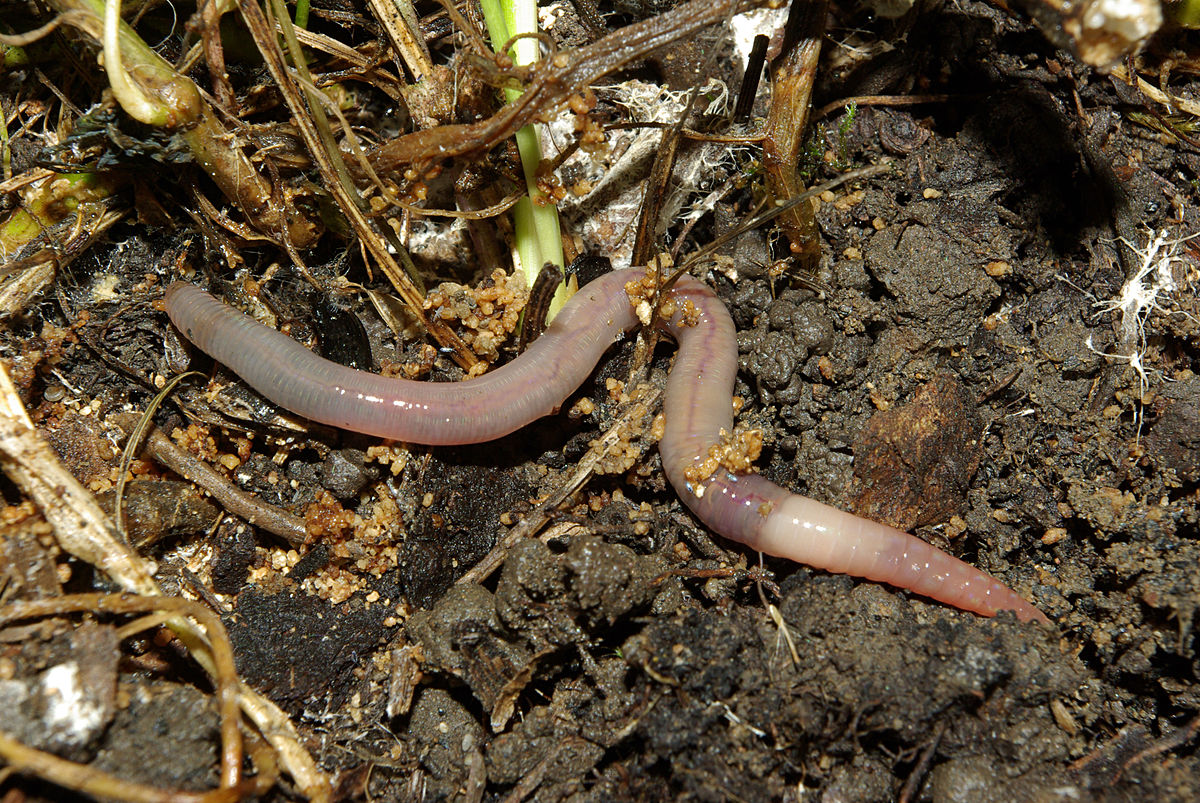
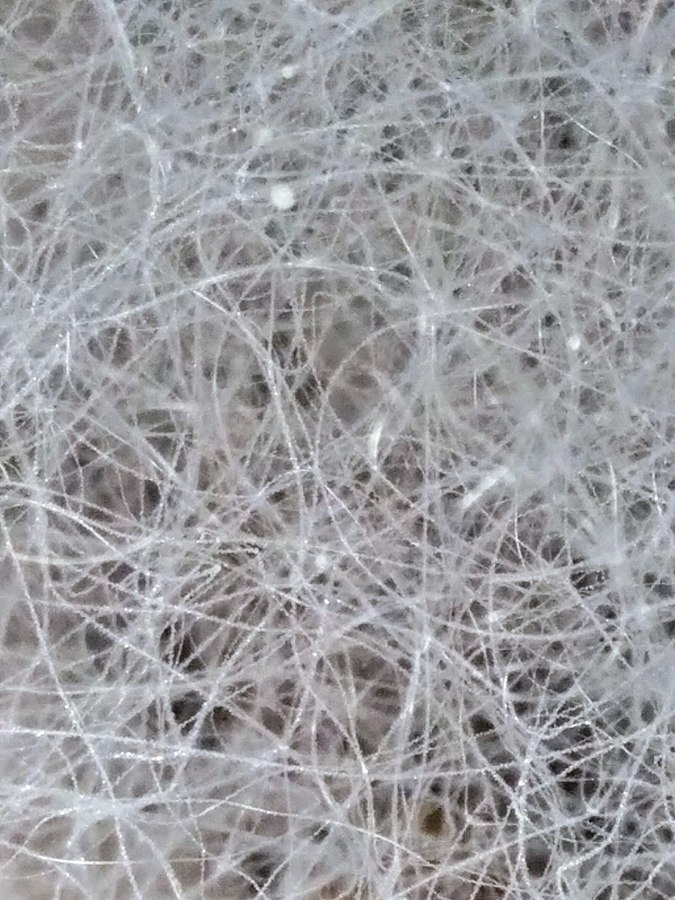
Key soil organisms:
Left: earthworms are very important in mixing material in the topsoil.
Right: mass of fungal filaments (hyphae). These are everywhere in soil, but not normally easy to see as they are minute, transparent, and wrapped around soil particles and roots/
Main soil types
Soils are made up of all the components above, but in varying proportions, and this strongly affects how they work with plants. The basic classification is based on the proportions of the different sized mineral particles present, as shown in this diagram.
The three extreme soil types are Sand, Silt and Clay, but pure soils of these are rare, and nearly all soils have a mixture. The “best” soil for growing crops is called loam, with approximately equal proportions of silt and sand, and not too much clay (roughly 40%-40%-20%). Some of the intermediate soil classes are shown in the diagram.
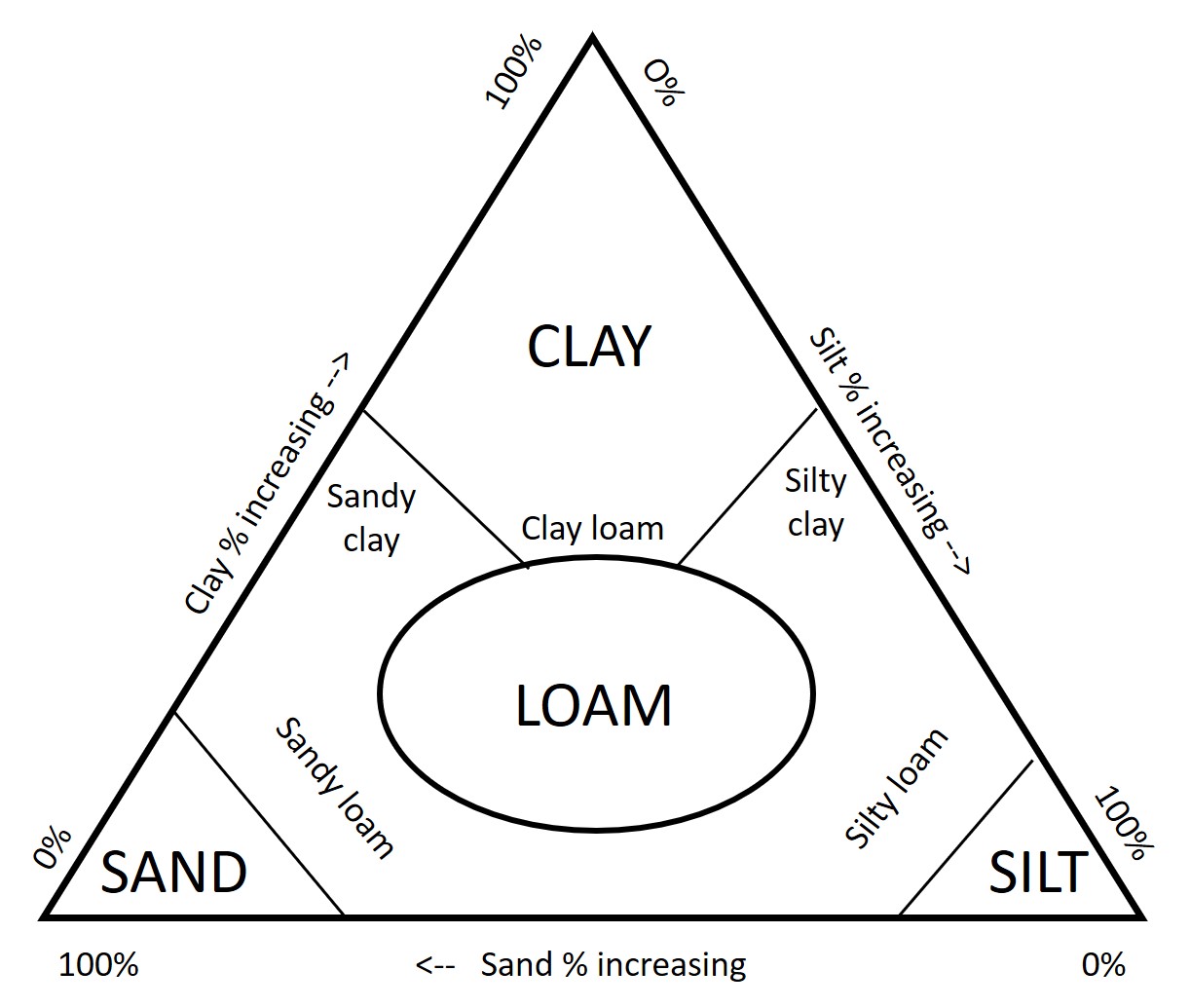
Sandy soils
Sand sized particles dominate these soils, which are light to work, but drain freely and so are prone to drought. They generally have low fertility because there is nothing to stop nutrients being washed out.
Sandy soils are common on heaths and moorlands as in this photo.
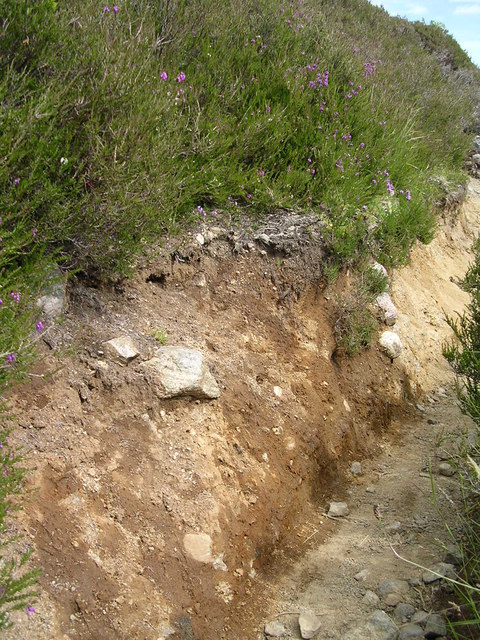
Clay soils
In complete contrast, clay soils are heavy and difficult to work. They trap water and are very sticky, wet and airless in winter, slow to warm up in spring, and can dry out and crack in summer as shown in the photo opposite.
Clay soils are inherently very fertile as clay particles hold nutrients, but plants need to be able to get at them.
The impenetrability of heavy clay soils can be reduced by the regular addition of plenty of organic matter helping to break the clay into separate crumbs, accessible to plant roots.
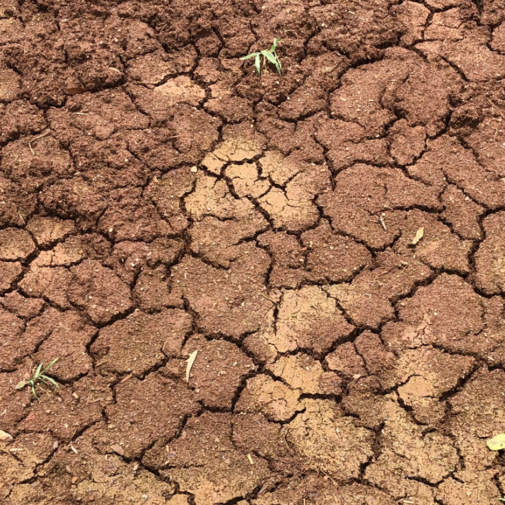
Silty soils
Silty soils are not as heavy as clay but are also prone to being airless through compaction. They tend to be quite fertile and to hold on to water well.
Silty soils are not common in gardens and are usually associated with coastal marshes and freshwater wetlands. Silt can build up quickly in bog garden soils.
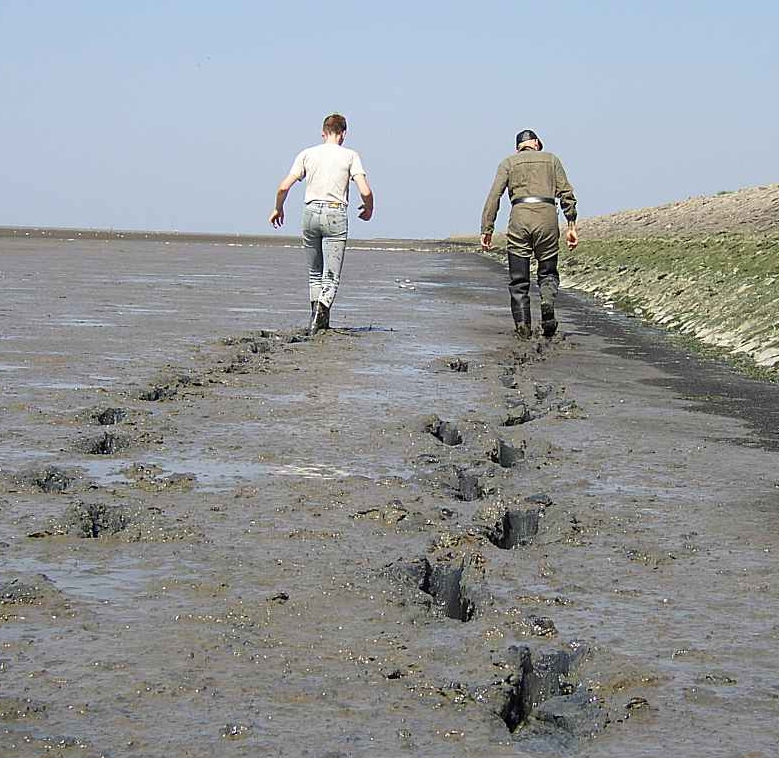
Peaty soils
Some soils, such as those in woodlands, can contain a very high humus content and can be very fertile where light can reach them. Peaty soils form naturally where the ground is saturated. They are rare in gardens (except in long-established bog gardens) but support unique and important communities of plants.
Peaty soils form in bogs and fens, often as practically pure organic material as in the excavated chunk of peat in the photo. Bogs are rain-fed and very acid. Fens on the other hand are neutral to alkaline, with their water coming from the ground with plenty of minerals. Peat habitats have been over-exploited for harvesting soil improvers, but the use of peat in horticulture is being phased out.
.jpg)
Loam soils
These avoid the pitfalls of the extremes, and so are fertile and provided they contain plenty of humus are generally desirable for gardeners and many wild plant species.
Other factors in soil character
Soil mineral texture and humus content are dominant, but other factors are important, such as drainage and the acidity or alkalinity of the soil.
Drainage.
It’s frustrating that so many planting guides recommend “moist but well-drained soil” because that sounds like an impossible combination. What it means is that the soil should be capable of holding moisture but is sufficiently permeable that it won’t go soggy for long after heavy rain. Saturated soils (including in plant pots) exclude air, preventing roots from obtaining the oxygen needed to keep them alive. Most loam soils stay moist and drain readily, but clay soils don’t drain without “improvement”. Another reason for poor drainage can be that the water table is close to the surface (especially in winter). This could be a good reason to make a bog garden in the area. The same problem can arise if there is a thick clay layer beneath otherwise decent loam. Raised beds lift the plants higher and can often solve drainage problems.
Sandy soils (and soils over very porous chalk) have the opposite problem of drying out too quickly. The answer is to add large quantities of home-made compost to raise the humus levels and retain moisture.
Acidity/alkalinity
Soils can be slightly acidic or alkaline depending on the geology of their mineral particles and the amount of humus. Acidity/alkalinity is measured on the pH scale, which runs from 0 to 14, with pH 7 as neutral. Your stomach is very acidic at about pH 1-2, while household bleach is strongly alkaline at about pH 13. Neutral soil is generally considered to fall between pH 6.5 and 7.1. You can measure your soil pH using a simple testing kit. The lower the pH, the more acidic the soil. Acid-loving (ericaceous) plants include rhododendrons, camellias, heathers and blueberries. Adding lime to acid soil will reduce its acidity. A slightly acidic soil of pH 5 -to 6.5 is the best general-purpose pH for gardens, allowing a wide range of plants to grow. Alkaline soils, with lots of chalk or limestone range from 7.1 to 8.0 and most ericaceous plants won’t thrive in them. There is no practical way of lowering the pH of very alkaline soils, so if you live in a chalky area but feel you must grow lime-hating plants, grow them in pots, and don’t water with lime-containing tap or well water.
In nature, plant communities growing on acid or chalky soils are very different. If you want to grow native wild flowers it is important that you match the species you choose to youir soil type, and seed merchants offer a variety of targeted mixes.
Soil profiles
Soils are not uniform from the surface to deeper down. They tend to form parallel layers or “horizons” with significantly different character, and these depend on the inherent geology of the minerals, the hydrology of the soil, and the level of disturbance. This is a very complex subject, but for our purposes the key horizons are the uppermost organic layer, the surface soil and the subsoil beneath it. Underneath these layers are broken-up rocky material, and finally the underlying bedrock.
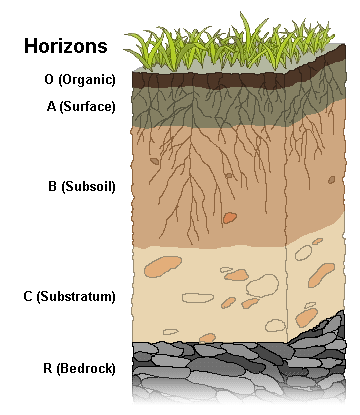
The organic layer contains detritus, decaying plant debris and the bases and roots of living plants. It is dark in colour and full of life.
The surface soil below contains humus and plant roots and is naturally mixed by the actions of earthworms and gardeners. It contains lots of nutrients, while the relatively undisturbed subsoil has much less. Roots penetrating to the subsoil and below are collecting water rather than nutrients.
If you are trying to establish a true wildflower meadow (a mix of grass and flowers) on highly fertile soil, it could be worth removing the surface soil and establishing your meadow on the much less fertile subsoil. This reduces the competitive advantage of grasses and allows other plants to thrive. See our guide to creating wildflower meadows.
Soil ecology
Most research on soils and their ecology has been focused on increasing fertility and productivity on agricultural land. Only recently has genomic analysis confirmed the extraordinary biodiversity present within soils, and we still understand little about how soil communities function because most soil organisms are minute and very hard to observe.
Soil hosts the highest bacterial diversity of all habitats. The number of genetically distinct bacteria “species” can be up to 1 million per gram of soil, with numbers of individuals reaching the billions1. These bacteria, about the size of silt particles, live in the film of water surrounding soil particles or plant roots.
A single teaspoon of garden soil may contain thousands of animal species, millions of individuals and a hundred metres of fungal networks2. It is estimated that at least a quarter of species on our planet live in soils.
A hectare of good loam contains about 1,000 kg of earthworms, 1,000 kg of arthropods, 150 kg of protozoa, 150 kg of algae, 1,700 kg of bacteria, and 2,700 kg of fungi3.
Estimates of numbers of larger soil animals per square metre of temperate grasslands
Harris, J.A. (1991) The biology of soils in urban areas. In Soils in the Urban Environment, Blackwell Scientific Publications
The links take you to our pages on each group
|
Group
|
Lower estimate
|
Upper estimate
|
|
1.8 million
|
120 million
|
|
|
20,000
|
120,000
|
|
|
10,000
|
40,000
|
|
|
Insects
|
1,200
|
2,400
|
|
Enchytraeid worms
|
500
|
20,000
|
|
500
|
9,000
|
|
|
500
|
2,000
|
|
|
200
|
900
|
|
|
200
|
400
|
|
|
100
|
2,000
|
Soil communities have food webs in the same way that above-ground habitats do, and ultimately they are fuelled by photosynthesis, but the actual source of carbon to the system is dominated by decaying organic material and exudates from plant roots, so the decomposer role of bacteria and fungi is much more important than the role of herbivores. The decomposers provide resources for protozoa and small multicellular animals, which in turn are consumed by predators. Birds and mammals dig for soil fauna, and return its biomass into the above- ground ecosystem, while the nutrient molecules released by the decomposers and excreted by the animals are available in recycled form to the roots of plants.
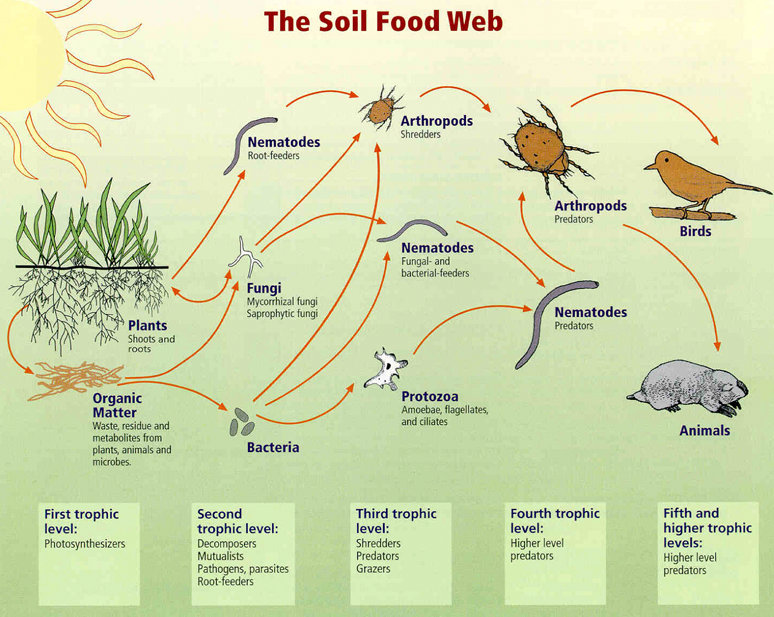
All once-living matter returns to the soil that it grew from, to be dismantled and cycled again. Without the constant recycling work of tiny animals, fungi and bacteria we would be metres deep in the remains of the dead, all resources frozen, new life impossible.
Soil recycling is supported by a constant flow of carbon from air to soil as plants release sugars and other organic compounds made by photosynthesis in their leaves out from their roots. These chemicals support the teeming billions of micro-organisms, fungi and bacteria that the roots partner with. In return for this carbon the soil micro-organisms help the plant to gather water and nutrients and to resist diseases.
Soil fertility
While all soils will support some plant growth, for maximum growth rates and productivity soils need to be very fertile, meaning they provide lots of inorganic nutrients (mainly nitrogen, phosphorus and potassium) and have good moisture retaining properties while avoiding becoming saturated. Natural undisturbed soils maintain adequate levels of fertility through natural processes, but fruit and vegetable growers will want to maintain high levels of fertility in the areas where they grow produce. For a wildlife garden however, high fertility, while not generally a problem, is certainly not necessary. Low fertility is very helpful when your desired plants are in competition with grasses as in a lawn or wildflower meadow patch.
Soils, erosion and climate change
Soils are massively important carbon sinks and the hidden subterranean world now known as the deep biosphere stores an estimated 15-23 billion tonnes of carbon, far more than is held in visible surface life.
Soils are easily degraded by human activities. Soil erosion occurs when soil hydrology is altered by drainage or removal of soil-binding trees and shrubs, causing soils to wash out or dry and blow away. Two posts at Holme Fen in Cambridgeshire record a drop in the peaty soil level of 4m since 1848 caused by shrinkage and wind-blow after drainage works.
Erosion is not usually a problem within gardens, but they may be affected by erosion externally. More commonly, garden soils are damaged by repeated digging in the same way that ploughing has damaged agricultural soils. Both cause the humus content to oxidise, reducing soil fertility unless replaced by application of compost, and reducing the carbon trapping ability of the land. Digging also destroys the subtly different layers of soil which support different species of soil fauna, so digging damages biodiversity. Application of artificial fertilisers disrupts soil ecology, as will contamination by pesticides and especially fungicides. This damage is far less visible to the wildlife gardener than would be the effects of these chemicals above ground.
Avoiding soil erosion, loss of stored carbon or ecological damage is a major concern for climate change, since all will contribute to atmospheric CO2 release.
There are now several initiatives to make agricultural soil management more sustainable4. and the same principles apply to garden soil management
Managing your soil
See our guide How to: Understand and maintain healthy soils
References
1. Bickel, S., Or, D. (2020) Soil bacterial diversity mediated by microscale aqueous-phase processes across biomes. Nat. Commun. 11:116 available here
2. European Commission (2010) The factory of life. Why soil biodiversity is so important. Luxembourg: Office for Official Publications of the European Communities. Available here
3. Pimentel, D. et al (1995). Environmental and economic costs of soil erosion and conservation benefits. Science. 267:1117–23. Available here
4. Farmer’s Weekly (2020) Regenerative farming: The theory and the farmers doing it. Available here
Books and websites
Lowenfels, J. and Lewis, W. (2010) Teaming with Microbes: The Organic Gardener's Guide to the Soil Food Web. Timber Press
RHS webpage on soil types https://www.rhs.org.uk/soil-composts-mulches/soil-types
Uksoils website https://uksoils.org/
British society of Soil Science website
Page drafted by Tony Kendle, extended and compiled by Steve Head, reviewed by Ken Thompson
Soils and wildlife gardens
Soils are amongst the most extensive and important ecosystems on earth. The total area of gardens in the UK is estimated at about 433,000 hectares, a fifth the size of Wales. Allotments cover a further 11,300 hectares. By caring for the health of those soils we can do much to protect biodiversity as well as grow healthy flowers and vegetables.
Soils are the product of thousands of years of co-creation by physical erosion processes and the plants and animals that depend on them. A healthy soil supports a full diversity of life above and below ground and is integral to its major processes and cycles such as carbon storage and water cycling.

Trengwainton kitchen garden in Cornwall. It's obvious that successful vegetable and fruit gardening depends on the state of your soil - but in fact everything in your garden requires healthy soil.
Components of soil
Soils are an intimate blend of mineral particles of a range of sizes, organic matter in varying stages of decay, water, air, plant nutrients and an amazing diversity of fungi, microbes and tiny animals. To be healthy, soils must contain all these components.
Minerals
Soil minerals arise from aeons of erosion of bedrock by frost, rain, roots and organic acids. They occur in particles ranging from extremely tiny to big stones.
|
Particle type
|
Particle diameter
|
|
Clay
|
less than 0.002mm
|
|
Silt
|
0.002mm to 0.063mm
|
|
Sand
|
0.063mm to 2mm
|
|
Gravel
|
2mm to 64mm
|
|
Cobbles
|
64mm to 25cm
|

Handful of rich brown humus
Gravel and sand make up the greatest part of soils by bulk. They are mostly chemically inert, often made up of flint and other forms of silica. They add little beyond structure, but that does not make them unimportant. The three-dimensional matrix they settle into creates many of the pores and channels by which roots grow into the depths and water and air can enter the soil.
The very smallest mineral particles, clays and silts, are very different. They have complex microstructures that create an enormous surface area for their mass. This and their ionic charges makes them chemically active; they bind to each other and they help to form the larger clods that also benefit soil structure. They hold water and plant nutrients that would otherwise drain away; they help to resist erosion, they also shelter the very tiniest bacteria, fine root hairs and fungal hyphae. Together with organic matter, clay particles are where most important soil processes take place.
Dead organic matter
Fully decayed organic matter, known as humus, is like clays in its properties, micro-porous and ionically charged, it too holds water and nutrients and provides shelter for microorganisms. Organic matter eventually oxidises and disappears, leaving soils dry and infertile, so a constant resupply is important to maintain levels of humus. In natural habitats this happens through the in-situ accumulation of dead leaves and twigs. Gardeners who remove “unsightly” dead plant material will have to replace it with mulches of compost.
Key soil organisms: Left: earthworms are very important in mixing material in the topsoil. Right: mass of fungal filaments (hyphae). These are everywhere in soil, but not normally easy to see as they are minute, transparent, and wrapped around soil particles and roots.


Plant nutrients
To grow well, plants need a wide range of nutrients in various amounts, depending on the individual plant and its stage of growth. The three key plant nutrients plant roots pick up (alongside water) from soil are nitrogen, phosphorus and potassium, while carbon dioxide is absorbed from the air. Other vital soil nutrients include magnesium, calcium and sulphur. Gardeners can add nutrients by applying fertilisers (either artificial or naturally derived) to boost plant growth and improve flowering and fruiting.
Air and water
Healthy soils contain air and water between the mineral grains. Water is essential for plant growth, while oxygen is needed for roots, and for the tiny animals in the soil. Both are usually available, but when soils are saturated with water, oxygen is excluded and toxic chemicals like hydrogen sulphide can build up. By contrast, very coarse sandy soils will have lots of air spaces but lose water quickly. Even the best soils can be easily damaged by compaction where machinery or people repeatedly walking on them compress the soil and destroy the network of spaces between grains. Raised beds are one way that gardeners can manage their plants without treading on the soil, and digging is then unnecessary.
Living creatures
Soils have a vital role in recycling dead plant and animal material, releasing their tissues back into soil as nutrients for plants. There are many types of animals which physically break up the dead matter, including woodlice, insects, mites and worms, plus a myriad of microscopic animals that carry on the process at a smaller scale. The most vital living soil creatures are the fungi, single-celled animals and bacteria that can break down material chemically to release nutrients. Indeed some bacteria also have a role in converting inert atmospheric nitrogen into chemically fixed nitrogen that plants can use. Some fungi have an equally vital role in forming symbiotic mycorrhizal associations with plant roots helping them take up water and nutrients.
Main soil types
Soils are made up of all the components above, but in varying proportions, and this strongly affects how they work with plants. The basic classification is based on the proportions of the different sized mineral particles present, as shown in this diagram.
The three extreme soil types are Sand, Silt and Clay, but pure soils of these are rare, and nearly all soils have a mixture. The “best” soil for growing crops is called loam, with approximately equal proportions of silt and sand, and not too much clay (roughly 40%-40%-20%). Some of the intermediate soil classes are shown in the diagram below.

Sandy soils
Sand sized particles dominate these soils, which are light to work, but drain freely and so are prone to drought. They generally have low fertility because there is nothing to stop nutrients being washed out.
Sandy soils are common on heaths and moorlands as in this photo.

Clay soils
In complete contrast, clay soils are heavy and difficult to work. They trap water and are very sticky, wet and airless in winter, slow to warm up in spring and can dry out and crack in summer as shown in the photo opposite.
Clay soils are inherently very fertile as clay particles hold nutrients, but plants need to be able to get at them.
The impenetrability of heavy clay soils can be reduced by the regular addition of plenty of organic matter helping to break the clay into separate crumbs, accessible to plant roots.


Silty soils
Silty soils are not as heavy as clay but are also prone to being airless through compaction. They tend to be quite fertile and to hold on to water well.
Silty soils are not common in gardens and are usually associated with coastal marshes and freshwater wetlands. Silt can build up quickly in bog garden soils.
Peaty soils
Some soils, such as those in woodlands, can contain a very high humus content and can be very fertile where light can reach them. Peaty soils form naturally where the ground is saturated. They are rare in gardens (except in long-established bog gardens) but support unique and important communities of plants.
.jpg)
Peaty soils form in bogs and fens, often as practically pure organic material as in the excavated chunk of peat in the photo. Bogs are rain-fed and very acid. Fens on the other hand are neutral to alkaline, with their water coming from the ground with plenty of minerals. Peat habitats have been over-exploited for harvesting soil improvers, but the use of peat in horticulture is being phased out.
Loam soils
These avoid the pitfalls of the extremes, and so are fertile and provided they contain plenty of humus are generally desirable for gardeners and many wild plant species.
Other factors in soil character
Soil mineral texture and humus content are dominant, but other factors are important, such as drainage and the acidity or alkalinity of the soil.
Drainage.
It’s frustrating that so many planting instructions recommend “moist but well-drained soil” because that sounds like an impossible combination. What it means is that the soil should be capable of holding moisture but is sufficiently permeable that it won’t go soggy for long after heavy rain. Saturated soils (including in plant pots) exclude air, preventing roots from obtaining the oxygen needed to keep them alive. Most loam soils stay moist and drain readily, but clay soils don’t drain without “improvement”. Another reason for poor drainage can be that the water table is close to the surface (especially in winter). This could be a good reason to make a bog garden in the area. The same problem can arise if there is a thick clay layer beneath otherwise decent loam. Raised beds lift the plants higher and can often solve drainage problems.
Sandy soils (and soils over very porous chalk) have the opposite problem of drying out too quickly. The answer is to add large quantities of home-made compost to raise the humus levels and retain moisture.
Acidity/alkalinity
Soils can be slightly acidic or alkaline depending on the geology of their mineral particles and the amount of humus. Acidity/alkalinity is measured on the pH scale, which runs from 0 to 14, with pH 7 as neutral. Your stomach is very acidic at about pH 1-2, while household bleach is strongly alkaline at about pH 13. Neutral soil is generally considered to fall between pH 6.5 and 7.1. You can measure your soil pH using a simple testing kit. The lower the pH, the more acidic the soil. Acid-loving (ericaceous) plants include rhododendrons, camellias, heathers and blueberries. Adding lime to acid soil will reduce its acidity. A slightly acidic soil of pH 5 to 6.5 is the best general-purpose pH for gardens, allowing a wide range of plants to grow. Alkaline soils, with lots of chalk or limestone range from 7.1 to 8.0 and most ericaceous plants won’t thrive in them. There is no practical way of lowering the pH of very alkaline soils, so if you live in a chalky area but feel you must grow lime-hating plants, grow them in pots, and don’t water with lime-containing tap or well water.
In nature, plant communities growing on acid or chalky soils are very different. If you want to grow native wild flowers it is important that you match the species you choose to your soil type, and seed merchants offer a variety of targeted mixes.
Soil profiles
Soils are not uniform from the surface to deeper down. They tend to form parallel layers or “horizons” with significantly different character, and these depend on the inherent geology of the minerals, the hydrology of the soil, and the level of disturbance. This is a very complex subject, but for our purposes the key horizons are the uppermost organic layer, the surface soil and the subsoil beneath it. Underneath these layers are broken-up rocky material, and finally the underlying bedrock.
The organic layer contains detritus, decaying plant debris and the bases and roots of living plants. It is dark in colour and full of life.
The surface soil below contains humus and plant roots and is naturally mixed by the actions of earthworms and gardeners. It contains lots of nutrients, while the relatively undisturbed subsoil has much less. Roots penetrating to the subsoil and below are collecting water rather than nutrients.

If you are trying to establish a true wildflower meadow (a mix of grass and flowers) on highly fertile soil, it could be worth removing the surface soil and establishing your meadow on the much less fertile subsoil. This reduces the competitive advantage of grasses and allows other plants to thrive. See our guide to creating wildflower meadows.
Soil ecology
Most research on soils and their ecology has been focused on increasing fertility and productivity on agricultural land. Only recently has genomic analysis confirmed the extraordinary biodiversity present within soils, and we still understand little about how soil communities function because most soil organisms are minute and very hard to observe.
Soil hosts the highest bacterial diversity of all habitats. The number of genetically distinct bacteria “species” can be up to 1 million per gram of soil, with numbers of individuals reaching the billions1. These bacteria, about the size of silt particles, live in the film of water surrounding soil particles or plant roots.
A single teaspoon of garden soil may contain thousands of animal species, millions of individuals and a hundred metres of fungal networks2. It is estimated that at least a quarter of species on our planet live in soils.
A hectare of good loam contains about 1,000 kg of earthworms, 1,000 kg of arthropods, 150 kg of protozoa, 150 kg of algae, 1,700 kg of bacteria, and 2,700 kg of fungi3.
|
Group
|
Lower estimate
|
Upper estimate
|
|
1.8 million
|
120 million
|
|
|
20,000
|
120,000
|
|
|
10,000
|
40,000
|
|
|
Insects
|
1,200
|
2,400
|
|
Enchytraeid worms
|
500
|
20,000
|
|
500
|
9,000
|
|
|
500
|
2,000
|
|
|
200
|
900
|
|
|
200
|
400
|
|
|
100
|
2,000
|
Estimates of numbers of larger soil animals per square metre of temperate grasslands. The links take you to our pages on each group
[Harris, J.A. (1991) The biology of soils in urban areas. In Soils in the Urban Environment, Blackwell Scientific Publications]
Estimates of numbers of larger soil animals per square metre of temperate grasslands. The links take you to our pages on each group
[Harris, J.A. (1991) The biology of soils in urban areas. In Soils in the Urban Environment, Blackwell Scientific Publications]

All once-living matter returns to the soil that it grew from, to be dismantled and cycled again. Without the constant recycling work of tiny animals, fungi and bacteria we would be metres deep in the remains of the dead, all resources frozen, new life impossible.
Soil recycling is supported by a constant flow of carbon from air to soil as plants release sugars and other organic compounds made by photosynthesis in their leaves out from their roots. These chemicals support the teeming billions of micro-organisms, fungi and bacteria that the roots partner with. In return for this carbon the soil micro-organisms help the plant to gather water and nutrients and to resist diseases.
Soil fertility
While all soils will support some plant growth, for maximum growth rates and productivity soils need to be very fertile, meaning they provide lots of inorganic nutrients (mainly nitrogen, phosphorus and potassium) and have good moisture retaining properties while avoiding becoming saturated. Natural undisturbed soils maintain adequate levels of fertility through natural processes, but fruit and vegetable growers will want to maintain high levels of fertility in the areas where they grow produce. For a wildlife garden however, high fertility, while not generally a problem, is certainly not necessary. Low fertility is very helpful when your desired plants are in competition with grasses as in a lawn or wildflower meadow patch.
Soils, erosion and climate change
Soils are massively important carbon sinks and the hidden subterranean world now known as the deep biosphere stores an estimated 15-23 billion tonnes of carbon, far more than is held in visible surface life.
Soils are easily degraded by human activities. Soil erosion occurs when soil hydrology is altered by drainage or removal of soil-binding trees and shrubs, causing soils to wash out or dry and blow away. Two posts at Holme Fen in Cambridgeshire record a drop in the peaty soil level of 4m since 1848 caused by shrinkage and wind-blow after drainage works.
Erosion is not usually a problem within gardens, but they may be affected by erosion externally. More commonly, garden soils are damaged by repeated digging in the same way that ploughing has damaged agricultural soils. Both cause the humus content to oxidise, reducing soil fertility unless replaced by application of compost, and reducing the carbon trapping ability of the land. Digging also destroys the subtly different layers of soil which support different species of soil fauna, so digging damages biodiversity. Application of artificial fertilisers disrupts soil ecology, as will contamination by pesticides and especially fungicides. This damage is far less visible to the wildlife gardener than would be the effects of these chemicals above ground.
Avoiding soil erosion, loss of stored carbon or ecological damage is a major concern for climate change, since all will contribute to atmospheric CO2 release.
There are now several initiatives to make agricultural soil management more sustainable4. and the same principles apply to garden soil management
Managing your soil
See our guide How to: Understand and maintain healthy soils
References
1. Bickel, S., Or, D. (2020) Soil bacterial diversity mediated by microscale aqueous-phase processes across biomes. Nat. Commun. 11:116 available here
2. European Commission (2010) The factory of life. Why soil biodiversity is so important. Luxembourg: Office for Official Publications of the European Communities. Available here
3. Pimentel, D. et al (1995). Environmental and economic costs of soil erosion and conservation benefits. Science. 267:1117–23. Available here
4. Farmer’s Weekly (2020) Regenerative farming: The theory and the farmers doing it. Available here
Books and websites
Lowenfels, J. and Lewis, W. (2010) Teaming with Microbes: The Organic Gardener's Guide to the Soil Food Web. Timber Press
British society of Soil Science website
Page drafted by Tony Kendle, extended and compiled by Steve Head, reviewed by Ken Thompson
Soil ecology
Most research on soils and their ecology has been focused on increasing fertility and productivity on agricultural land. Only recently has genomic analysis confirmed the extraordinary biodiversity present within soils, and we still understand little about how soil communities function because most soil organisms are minute and very hard to observe.
Soil hosts the highest bacterial diversity of all habitats. The number of genetically distinct bacteria “species” can be up to 1 million per gram of soil, with numbers of individuals reaching the billions1. These bacteria, about the size of silt particles, live in the film of water surrounding soil particles or plant roots.
A single teaspoon of garden soil may contain thousands of animal species, millions of individuals and a hundred metres of fungal networks2. It is estimated that at least a quarter of species on our planet live in soils.
A hectare of good loam contains about 1,000 kg of earthworms, 1,000 kg of arthropods, 150 kg of protozoa, 150 kg of algae, 1,700 kg of bacteria, and 2,700 kg of fungi3.
Estimates of numbers of larger soil animals per square metre of temperate grasslands. The links take you to our pages on each group
[Harris, J.A. (1991) The biology of soils in urban areas. In Soils in the Urban Environment, Blackwell Scientific Publications]
Soil communities have food webs in the same way that above-ground habitats do, and ultimately they are fuelled by photosynthesis, but the actual source of carbon to the system is dominated by decaying organic material and exudates from plant roots, so the decomposer role of bacteria and fungi is much more important than the role of herbivores. The decomposers provide resources for protozoa and small multicellular animals, which in turn are consumed by predators. Birds and mammals dig for soil fauna, and return its biomass into the above- ground ecosystem, while the nutrient molecules released by the decomposers and excreted by the animals are available in recycled form to the roots of plants.












